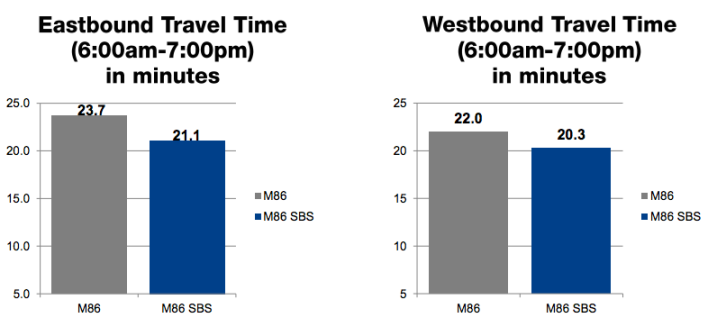
Buses on the M86 are moving faster and people have noticed -- ridership on the crosstown route is on the upswing again after declining for years.
The improved performance is due mainly to two changes the MTA and DOT launched last year: off-board fare collection with all-door boarding, and "queue jumps" at two locations that let buses move up to the front of the line at traffic lights. With faster boarding and less time in traffic, buses are traveling eight to 11 percent faster, and ridership is up about 10 percent from the previous year, according to the agencies [PDF].
These are the same kind of improvements that the NYC Bus Turnaround coalition wants to apply across the whole system. But while DOT has indicated that it supports more queue jumps, the MTA has refused to get behind the idea of all-door boarding on every bus.
Faster boarding is a big deal because the current boarding process, where riders dip a MetroCard or pay in cash one by one, significantly slows down buses. On the B44, for example, buses used to spend more than a quarter of the time stopping to pick up and drop off passengers. After the implementation of all-door boarding and off-board fare collection, that process became 40 percent faster [PDF].
As the MTA considers bids for its new fare payment system, advocates have called on the agency to ensure the system has the necessary technology for all-door boarding. That technology, electronic proof of payment, would allow riders to "tap-and-go" at bus stops or as they board.
Addressing the topic at yesterday's City Council hearing on bus service, however, MTA staff would not commit to universal all-door boarding.
“We must exercise diligence in considering all the operational and cost implications, in addition to the benefits, in evaluating a possible future decision to expand [all-door boarding] beyond SBS routes,” said New York City Transit Executive Vice President Craig Cipriano. He added that the agency was particularly concerned about fare evasion.
Experience in San Francisco and right here in New York proves that fare evasion is not the problem the MTA makes it out to be. The SF MTA implemented all-door boarding system-wide since 2012. Not only did fare evasion not increase, it continued on a downward trend that began before all-door boarding was implemented. In New York, fare evasion consistently declines after the launch of SBS routes with all-door boarding.
The only thing holding back all-door boarding on every route, it seems, is the MTA's own reluctance to go the extra mile for bus riders.





